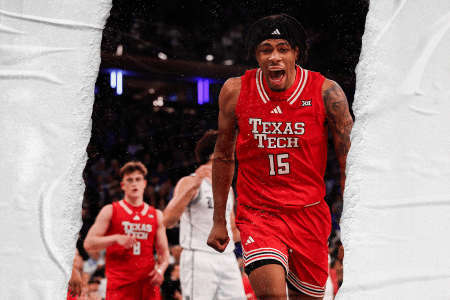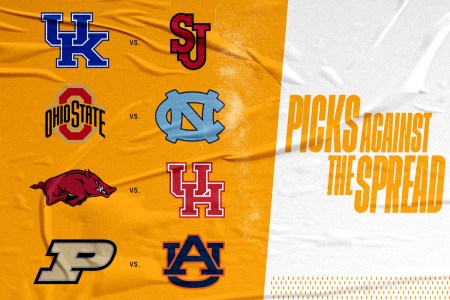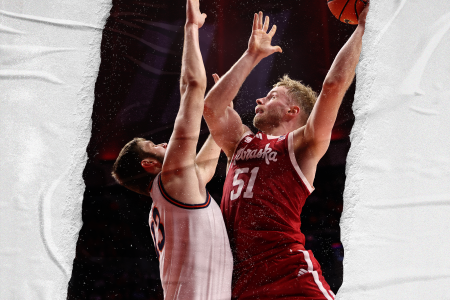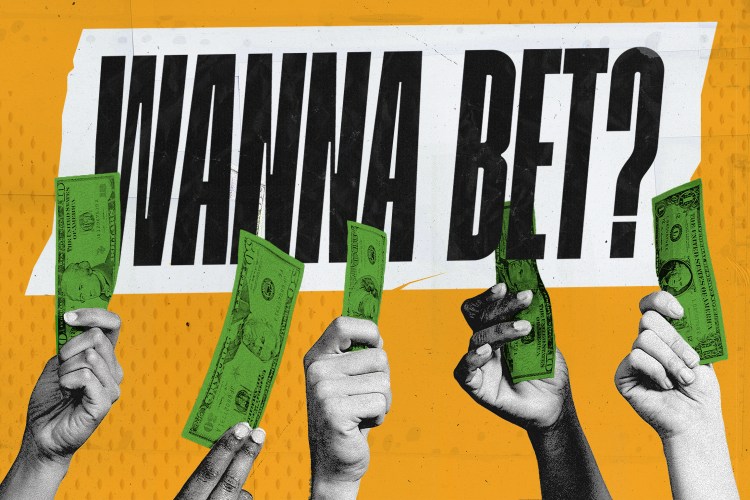Below is an excerpt from Pipeline to the Pros: How D3, Small-College Nobodies Rose to Rule the NBA by Ben Kaplan and Danny Parkins. Reprinted with the permission of Triumph Books.

Stan Van Gundy remembers receiving the phone call from Orlando Magic general manager Otis Smith that fateful morning in the summer of 2011. “You’re on SportsCenter,” Smith told Van Gundy, the Magic head coach. “I don’t know how the hell they got it.”
In the video, the mustachioed Van Gundy, wearing glasses, a long-sleeved gray shirt, and some striped blue shorts, calls for a ball. While encouraging campers to experiment with different dribbling combinations, he walks on to the empty court and unleashes a through-the-legs-behind-the-back combo followed by a crisp spin move and between the legs crossover. People in the audience gasp.
Bloggers and the nascent NBA Twitter community swarmed to the 15-second clip like ants on a dropped lollipop. The spirit behind the video’s viral popularity made it abundantly clear: nobody expected the 50-some-odd-year-old coach to have handles like that. “People look at me: short, fat guy coaching, and just assume I could never do anything,” Van Gundy said. “The bar was low. So the fact that you can get the ball from one hand to the other, people were even surprised by that.”
Stan’s younger brother, Jeff, also a former NBA coach, claims to have shared his brother’s ability to dazzle on the court — as long as nobody was actually guarding him. “When I was doing individual workouts, I could beat the cones on the court off the dribble every time,” Jeff told Dan Patrick for a 2015 column in Sports Illustrated. “It was those darn other players that got in the way of my greatness.”
Self-deprecating comments aside, the Van Gundy brothers were once accomplished collegiate players. Stan, who originally committed to Division II UC-Davis, had a change of heart when his dad took the head coaching job at Brockport State, a Division III public college just outside of Rochester, New York. With his parents and brother set to move from their Bay Area home, Stan decided at the last minute to tag along and enroll at Brockport State. Since his dad was the coach, he knew two things — he would have a spot on the team, and the coach would be really tough on him.
Standing just 5’7” and rail thin, Stan never missed a single game in his four years at Brockport St. He didn’t shoot much, but when he did, he made a high percentage. Over the course of his sophomore and junior seasons, he sank a school-record 53 consecutive free throws. Stan was also an excellent student — a double-major in physical education and English who graduated summa cum laude with a 3.83 GPA. Thanks to his combined excellence on the court and in the classroom, Stan won his school’s and his conference’s outstanding student-athlete awards.
Even though Stan was a solid player in his own right, his younger brother was the more accomplished on the court. Jeff originally enrolled at Yale University, but the assistant coach who recruited him left the school. After fall pickup games, the coaches informed Jeff he would be playing JV. “Getting cut, just like getting fired later in life, it’s a body blow whenever anyone tells you they’re better off without you,” Jeff said.
During his freshman year at Yale, Jeff wrestled with a decision — should he sacrifice an Ivy League education so he could transfer and play varsity college ball, or should he stay and effectively give up on hoops? He ultimately opted to leave Yale.
Had he transferred directly to a D3 school, he would have had to sit out a year. So Jeff Van Gundy became the first and (probably) only person to ever transfer from Yale University to Menlo Junior College. Then, after a year at Menlo, it was off to Brockport to play for his father. That arrangement also lasted just one season. His dad was fired, so Jeff, who was voted team MVP and named captain for the upcoming season, refused to stay. He transferred to Nazareth College, his fourth school in four years. “He kind of was before his time,” said Bill Nelson, the coach who recruited Jeff to Nazareth. “He was his own transfer portal.”
The match between Van Gundy and Nazareth turned out idyllic, a marriage well worth the three divorces preceding it. “It was one of the best decisions of his life,” said Bill Van Gundy, Jeff’s dad.
In Jeff’s first season at Nazareth, the team won their NCAA Regional and earned a trip to the Division III quarterfinals. Nazareth played Clark University with a trip to the Final Four on the line. Clark’s coach, Wally Halas, remembers focusing his pregame scouting efforts on Van Gundy. “He was a tough, small point guard,” Halas said. “Knew how to play, could score a little bit, dogged defender, just a really solid, good Division III guard.” Van Gundy went toe to toe with Clark’s star guard, Dan Trant, who the Boston Celtics drafted later that year, but Clark outlasted Nazareth for the win.
That spring, Nazareth graduated four of their starters. Coach Nelson prepared Jeff, the lone remaining starter, for a rebuilding season. Nelson remembered his point guard growing furious, telling him, “Rebuilding’s for losers.” Jeff set a high bar in offseason workouts, which bled into the regular season. The “rebuilding” team went 20–5. Jeff set a single-season school assist record and was named to the All-East Region team. Nelson calls Jeff the best defensive player he ever coached, one who always matched up with the opposing team’s top guard. When asked to recall a quintessential Van Gundy play, Nelson describes Jeff’s unique ability to scramble from the top of the key down to the baseline as a help defender to take a charge. “He would go flying into the wall,” Nelson said, “whether he should or shouldn’t have.” The robust Rochester D3 community knew him as “All-Out Jeff.”
“He must have a heart like Secretariat,” said Nelson, who sat “All-Out Jeff” on the bench only two minutes per game. “He was just relentless out there.”
As a high school senior, Rochester area resident Kevin Broderick attended a Nazareth game to get a feel for the Division III level. He was blown away by Van Gundy, who hounded the ball on defense and played so precisely and efficiently on offense. If that’s what Division III point guards look like, Broderick thought, I’m done here.
Even opposing coaches left a game against Nazareth in awe. “Jeff is the biggest over-achiever [sic] I have seen in basketball,” Geneseo St. coach Tom Pope told Nazareth’s student paper, The Gleaner. “He’s not big, he’s not fast, he’s not quick. He just beats you with enthusiasm, hustle, poise, and tremendous knowledge of the game. He’s a genuine coach on the floor.”
Jeff acted like a coach off the floor as well. When Nelson would scout local teams, sometimes he’d look across the stands and, to his surprise, see Jeff sitting there, taking in the action. During one Nazareth game, an opponent busted out an exotic defense — an inverted triangle and two. Nelson called timeout. Before he could speak, Jeff took charge of the huddle and broke down exactly how to attack the defense. Sure enough, his strategy worked to perfection.
The most ludicrous chapter in Jeff’s Nazareth lore took place at Roanoke College. The game was heading for a second overtime when one of the referees called a technical foul on the Nazareth assistant coach for arguing. With no time on the clock, Roanoke made both technical free throws. The referees waved their arms, signaling the end of the game. Rather than accept the loss, Jeff gathered the refs together. “Listen!” he said. “My father’s a coach, and I’ve been in this situation before. These points should go into the second overtime.” Convinced by Jeff’s confidence, the refs reversed their decision. They applied the two free throws to the beginning of the second overtime and called the teams back to the floor.
A few years later, one of the referees from that game ran into Nelson. “You son of a bitch!” the ref said. “You don’t know how much trouble we got in by making that mistake.” Turns out, Jeff was wrong. Those free throws at the end of the first overtime should’ve ended the game. And they would have, had he not sprung to action.
When asked to provide a scouting report on his kids, the elder Coach Van Gundy said that his boys were “as good as players as their abilities would take them. Stan was very unathletic. Stan lacked quickness, of course. Size definitely was not there. But he was a very skilled ballhandler. He didn’t turn the ball over. He was a very good shooter. Let’s say this: his performance went beyond his ability. Jeff was a better athlete, though not a great one by any means. But he saw playing differently than Stan. Stan shot the ball, and I’m going to tell you the term ‘shot selection’ during his high school years was not a major term at all. Jeff worked and became a good shooter, but he had to really work at that. He actually saw the role that he was playing as he was running an offense. The combination of the two would’ve really been a good player.”











